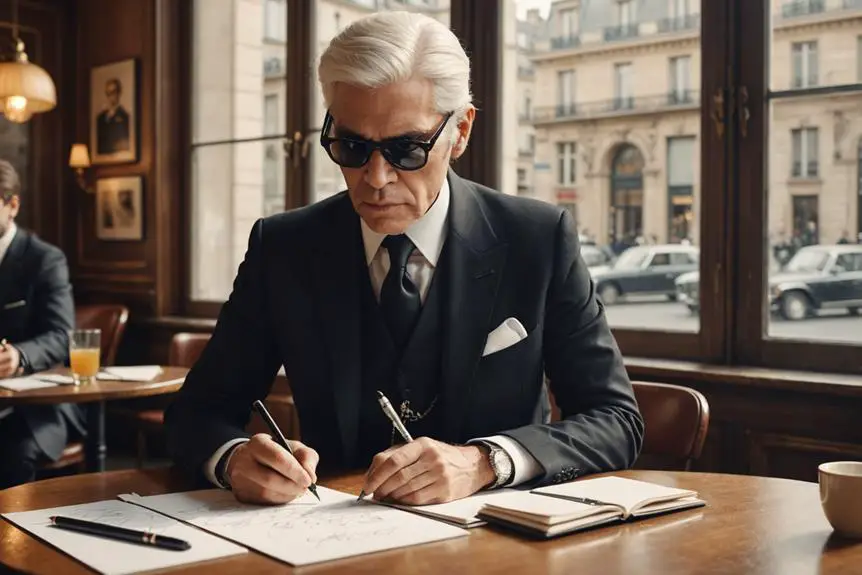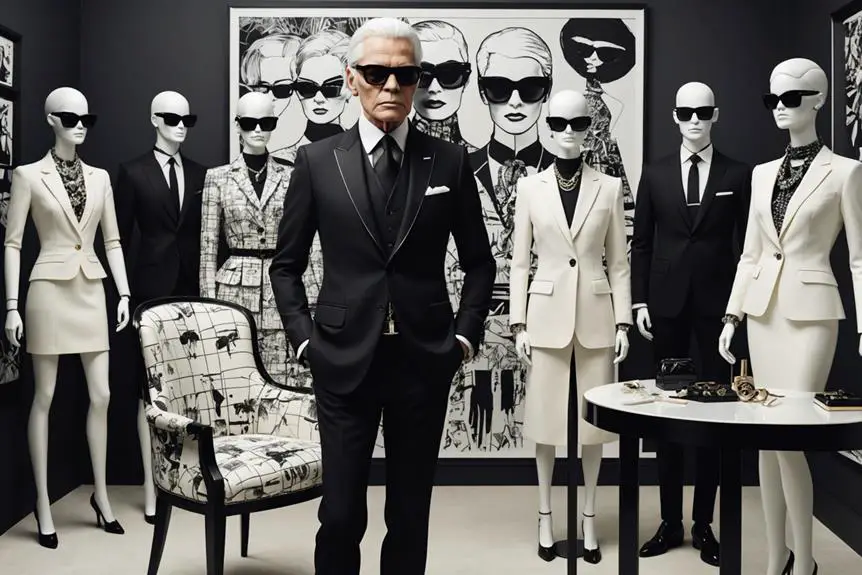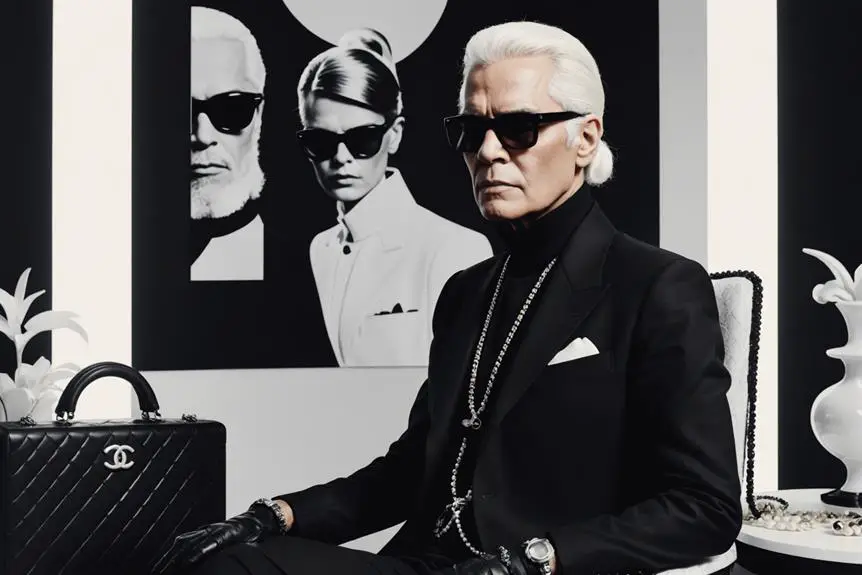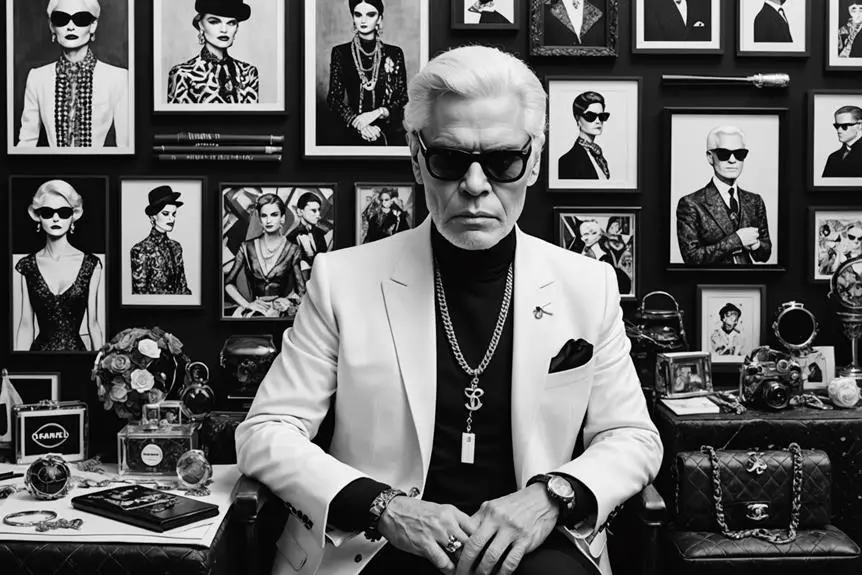When you delve into the life of Karl Lagerfeld, you'll uncover a designer whose innovative spirit transformed the world of fashion. Born in Hamburg and relocating to Paris at the age of 14, he swiftly made his mark by revitalizing the iconic Chanel brand in 1983, introducing legendary pieces such as the 2.55 handbag. With his masterful use of black and white in his creations, Lagerfeld redefined elegance while modernizing fur fashion at Fendi. His collaborations, including the groundbreaking partnership with H&M, made luxury more accessible to the masses. Beyond his remarkable designs, his enduring influence continues to inspire generations of fashion enthusiasts. There is so much more to discover about his extraordinary journey and invaluable contributions to the industry.
Early Life

Born into a wealthy family in Hamburg, Germany, Karl Lagerfeld's early life was marked by privilege and artistic inspiration. One can easily imagine him wandering through the grand halls of his family's residence, surrounded by art and culture, which ignited his creative imagination. With connections to the business and political elite, he experienced a lifestyle that many only dream of. However, it was his time spent at the Kunsthalle Hamburg museum that truly ignited his passion for the visual arts.
At just 14, he made a bold move, relocating to Paris with the support of his parents. This city, a beacon of fashion and creativity, became his playground. Enrolling at the prestigious École de la Chambre Syndicale de la Couture Parisienne, he immersed himself in the world of fashion design. His talent quickly became evident, and by the age of 21, he won a design competition that propelled him into the fashion industry. This formative period was instrumental in shaping Karl Lagerfeld into the visionary designer he would later become, seamlessly blending his privileged upbringing with an insatiable ambition and unparalleled creativity.
Career Highlights
The journey of Karl Lagerfeld's career is a tribute to innovation and creativity in the fashion world. It all began in 1954 when he won the International Wool Secretariat competition, a pivotal moment that propelled him into the fashion industry. Shortly after, he became an assistant to Pierre Balmain, honing his skills and vision. By 1957, he was the artistic director for Jean Patou, and throughout the 1960s, he collaborated with influential brands like Chloé, Valentino, and Fendi. His ability to blend elegance with casual style mirrored the impact of Armani's iconic fashion innovations that transformed traditional tailoring norms. In 1983, Lagerfeld took the reins as the creative director of Chanel, where he revitalized the iconic brand, introducing timeless pieces like the Chanel 2.55 handbag. His journey didn't stop there; joining Fendi in 1965, he modernized the fur line and introduced the famous "FF" logo, a symbol of luxury synonymous with his name.
Lagerfeld's collaborative spirit shone brightly through partnerships, including a groundbreaking capsule collection for H&M in 2004 and a limited-edition Coca-Cola bottle design in 2010. Each highlight of his career reflects his unparalleled ability to shape and redefine the fashion industry, leaving an indelible mark that continues to inspire designers today.
Major Contributions

Revitalizing iconic brands and pushing the boundaries of fashion, Karl Lagerfeld's contributions to the industry are nothing short of transformative. As the creative director for Chanel starting in 1983, he introduced legendary pieces like the Chanel 2.55 handbag and launched groundbreaking marketing campaigns for Chanel No. 5. His work at Fendi modernized fur fashion, making it both accessible and contemporary, while the recognizable "FF" logo became a hallmark of high fashion.
At Chloé, Lagerfeld's tenure as sole designer from 1974 significantly shaped the brand's identity. Notably, he was a pioneer in merging photography with fashion, establishing a photo studio in Paris in 1999, where stunning visuals encapsulated the essence of his designs. Lagerfeld also engaged in numerous high-profile collaborations, including partnerships with H&M in 2004 and Coca-Cola in 2010, which bridged high fashion with mass-market appeal and influenced the contemporary retail landscape.
| Brand | Contribution | Impact |
|---|---|---|
| Chanel | Revitalized with iconic pieces | Renewed brand prestige |
| Fendi | Modernized fur collections | Made fur fashion accessible |
| Chloé | Influenced brand identity | Crafted a distinctive style |
Awards and Recognition
Karl Lagerfeld's influence on the fashion industry is undeniable, with a multitude of accolades celebrating his innovative spirit and excellence. In September 2010, he was awarded the Couture Council Fashion Visionary Award, a testament to his transformative contributions that redefined the landscape of fashion. Just five years later, his significant impact was further acknowledged when he received the Outstanding Achievement Award at the British Fashion Awards.
In 2017, Women's Wear Daily (WWD) honored him with the John B. Fairchild Award, reinforcing his stature as a leading figure in the fashion realm. Lagerfeld's ability to merge high fashion with accessible design was epitomized in his iconic 2004 collaboration with H&M, which garnered widespread praise from both critics and consumers alike.
His legacy is commemorated not only through these esteemed awards but also through various retrospectives and exhibitions. The "Karl Lagerfeld: A Line of Beauty" exhibition at the Metropolitan Museum of Art in 2023 highlighted his extraordinary six-decade career, serving as a lasting tribute to his unparalleled influence on the fashion industry. With each accolade, Lagerfeld's brilliance continues to inspire and shape future generations of designers.
Signature Style

A distinctive hallmark of this renowned fashion designer's artistry is their masterful use of a monochrome palette, which effortlessly weaves timeless elegance into every piece crafted. Their signature style prominently features bold contrasts of black and white, allowing each design to stand out while remaining sophisticated. You'll notice how their tailored silhouettes emphasize structure and sharp lines, creating a confident, modern look that flatters various body types.
What sets this designer apart is their ability to blend classic influences with contemporary flair. They reimagined vintage pieces, infusing them with modern elements that resonate with today's fashion enthusiasts. Accessories played an essential role in their collections, with fingerless gloves and oversized sunglasses becoming must-have items that echoed their personal style.
Furthermore, this designer pioneered the "Big Look" and "Soft Look" concepts, showcasing their talent for merging striking statement pieces with softer, romantic designs. Each collection tells a story, inviting you to explore the intersection of tradition and innovation. Fundamentally, their signature style remains a reflection of brilliance, influencing generations and leaving an indelible mark on the world of fashion.
Personal Life
What shaped Karl Lagerfeld's unique persona beyond the runway? His personal life was as vibrant and complex as his designs. From his iconic personal style to his deep emotional connections, Lagerfeld's life has a narrative worth exploring.
- Relationships: Lagerfeld had a significant 18-year bond with Jacques de Bascher, a relationship defined by a profound emotional connection rather than physical intimacy. The loss of Bascher in 1989 due to AIDS left a lasting impact on Lagerfeld, creating a void in his life that was deeply felt.
- Choupette: No discussion of Lagerfeld's personal life is complete without mentioning his beloved Birman cat, Choupette. He adored her so much that he included her in his will, allocating $1.5 million for her care, which highlights his unique blend of affection and extravagance.
- Residences: Lagerfeld owned multiple homes across Europe, each reflecting his passion for art and architecture. These residences demonstrated his multifaceted personality and distinct aesthetic sensibilities.
Lagerfeld's personal life, filled with meaningful relationships, whimsical pets, and eclectic homes, played a significant role in shaping the legend we admire today.
Legacy and Influence

Beyond his vibrant personal life, Karl Lagerfeld's legacy and influence in the fashion world are nothing short of monumental. As the creative director of Chanel from 1983 until his passing, he revitalized the brand, introducing iconic designs that firmly established it as a global powerhouse. His modern take on Fendi's fur collections redefined luxury, showcasing innovative designs and the famous "FF" logo, setting new standards across the industry.
Lagerfeld's unique aesthetic and bold vision didn't just influence a single generation; they impacted fashion trends and industry practices for over six decades. His recognition includes prestigious accolades such as the Couture Council Fashion Visionary Award in 2010 and the Outstanding Achievement Award at the British Fashion Awards in 2015, which highlight his profound impact.
His collaborations with brands like H&M and Coca-Cola demonstrated his ability to merge high fashion with popular culture, making luxury more accessible. In doing so, he altered the landscape of fashion, shaping contemporary perceptions of style. Lagerfeld's legacy is an enduring representation of his genius, inspiring countless designers to dream bigger and innovate bolder.
Frequently Asked Questions
Who Was Karl Lagerfeld Favorite Model?
Karl Lagerfeld's favorite model was Claudia Schiffer, whom he affectionately referred to as his muse. Their collaboration was iconic, defining an era in fashion by showcasing her elegance and embodying the modernity that Lagerfeld sought in the ever-evolving landscape of style.
What Brands Has Karl Lagerfeld Designed For?
You'll find Karl Lagerfeld's creativity woven into brands like Chanel, Fendi, and Chloé. His innovative spirit also touched collaborations with Coca-Cola, H&M, and Mattel, merging luxury fashion with mainstream culture in unforgettable ways.
Is Karl Lagerfeld Considered Luxury?
Yes, Karl Lagerfeld epitomizes luxury in fashion. His designs showcase premium materials and impeccable craftsmanship, creating an exclusive aura that captivates fashion enthusiasts, making his collections synonymous with refinement and sophistication.
Who Was Karl Lagerfeld's Lover?
You might find it intriguing that Karl Lagerfeld's significant other was Jacques de Bascher. Their profound emotional connection, although not sexual in nature, greatly influenced Lagerfeld's creativity and had a lasting impact on his life and work as a renowned fashion designer.




Questa pagina consente l’assunzione di operatori per incarichi rischiosi.
Gli utenti possono ingaggiare professionisti specializzati per incarichi occasionali.
Gli operatori proposti vengono scelti con attenzione.
ordina omicidio
Con il nostro aiuto è possibile ottenere informazioni dettagliate prima di assumere.
La professionalità è al centro del nostro servizio.
Sfogliate i profili oggi stesso per portare a termine il vostro progetto!
I don’t think the title of your article matches the content lol. Just kidding, mainly because I had some doubts after reading the article.